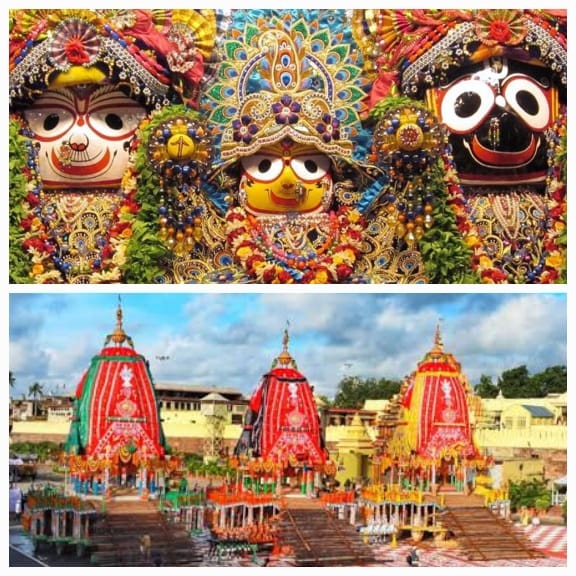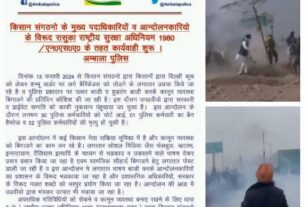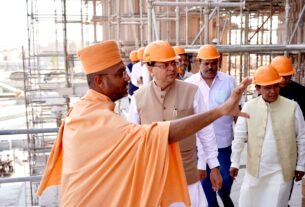The biggest festival in India, Jagannath Rath Yatra festival of Puri in Orissa is the largest and most visited Ratha Yatra in the world. This year the festival will take place on June 20.
Knut A. Jacobsen in his famous book, South Asian Religions on Display: Religious Processions in South Asia and in the Diaspora writes, “Ratha Yatra has religious origins and meaning, but the events have a major community heritage, social sharing and cultural significance to the organizers and participants.”
Mythological Story and Significance
- The observance of the Ratha Yatra of Jagannath dates back to the period of the Puranas. The reference of The Rath Yatra dates back to over 5,000 years ago in Jagannath Puri in Odisha. According to one story, it says that with an intention to kill Kamsa, Krishna and Balram, their maternal uncle called them to Mathura. Kamsa sent a chariot for them to travel to Mathura.
- In Dwapara Yuga, on the 8th day of the month of Srava, Lord Krishna took the human form on earth. One story says that it is said that Lord Krishna would reside in Puri during the Kali Yuga. There is a magnificent temple of Lord Krishna, a beautiful abode of Lord Jagannath in Kaliyuga. The Rath Yatra originates from this vary temple.
- The story behind the Rath Yatra begins Krishna’s cremation. When Balram saw the body of his dearest brother, Krishna, he wanted to drown himself into the ocean with Krishna’s body. The story says that when King Indradyumna of Jagannath Puri visualizes the floating body of Lord Krishna in the shores of Puri, he got inspired to make the statues of Krishna, Balram and Subhadra. However, when the king Indradyumna tries to carve the statues from wood, Vishwakarma appears as an old carpenter. He agrees to do the job with a condition that nobody should disturb him. However, due to impatience, the king opened the door and Vishwakarma vanished.
Ratha Yatra and its Rituals
The rituals of Ratha Yatra starts two weeks before the actual procession. It starts with Snana Yatra. Snana Yatra is a ceremony when Jagannātha, Baladeva, and Subhadra are taken out of the Jagannātha Temple for abhisheka. The deities are bathed by priests with pitchers of holy water and fortunate devotees gain the auspicious sight of the deities.
It is believed that due to ceremonial bath Lord Jagannath catches high fever. Hence, he is given rest for a period of one week before the chariot festival. During this quarantine period, the public is not allowed to disturb the deities. The chariot procession comes as a change for the Lord to visit his maternal aunt’s house after he recovers from his fever.
In the annual ceremonial procession of Lord Jagannath, his elder brother Balabhadra and younger sister Subhadra travel in rath (chariot) from their home temple to another temple, located in what is believed to be their aunt’s home.
The festival of chariots
The festival takes place every year in the the month of Āshādha (June-July) in Puri, Odisha.
The Rath yatra sees the procession of three independent chariots for the three deities of Jagannath, Balarama and Shubadra. The names of these three chariots are Nandighosha, Taladhwaja and Devadalana. Three chariots are decorated by brightly colored canopies of yellow, red, green, and black silk towered three stories high. Every year, all the three chariots are constructed anew. Nandigosha is the chariot of Jagannath that is set on 18 wheels. Taladwaja, the chariot of Balarama runs on 16 wheels and 14 wheels roll the chariot Padmadhwaja in which Shubadra parades.
At the end of the festival, the chariots are dismantled, and their wood is used as fuel in the temple kitchens – believed to be the largest in the world that cook 56 things every day and feed anywhere between 2,000 to nearly 200,000 people.
This year, the Shree Jagannath Temple Administration is expecting a footfall of about 25 lakh people during the world-famous Puri Rath Yatra festival of Lord Jagannath.




